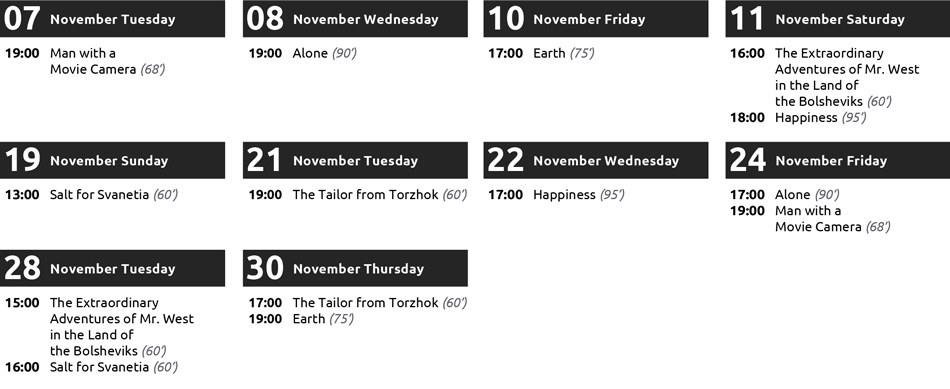“The art of cinema is the most important of all arts for us today!”
Lenin
Pera Film is saluting the Bolshevik Revolution Centenary with a special program titled Red Revolution: Soviet Gems. The program brings together seven black and white, classic films from the cinema of the Soviet Union. The Bolshevik Revolution of 1917 was one of the most explosive political events of the 20th century. The revolution marked the end of the Romanov dynasty and centuries of Russian Imperial rule. During the revolution, the Bolsheviks, led by leftist revolutionary Vladimir Lenin, seized power and destroyed the tradition of Czarist rule. The Bolsheviks would later become the Communist Party of the Soviet Union. On November 6 and 7, 1917 (or October 24 and 25 on the Julian calendar, which is why the event is often referred to as the October Revolution), leftist revolutionaries led by Bolshevik Party leader Vladimir Lenin launched a coup d’état against the Duma’s provisional government. The provisional government had been assembled by a group of leaders from Russia’s bourgeois capitalist class. Lenin instead called for a Soviet government that would be ruled directly by councils of soldiers, peasants and workers. Lenin now proclaimed a new government of Russia, by the Soviets. The Congress of Soviets met and endorsed the action of the Bolsheviks. The Bolshevik Revolution was now a fact.
Red Revolution: Soviet Gems celebrates the work of Grigori Kozintsev, Leonid Trauberg, Dziga Vertov, Aleksandr Dovzhenko, Mikhail Kalatozov, Lev Kuleshov, Aleksandr Medvedkin and Yakov Protazanov. From early dramas, comedies and melodramas to the emergence of the avant-garde in the 1920s, and 1930s, this program explores encaptivating cinematic treasures!
This program’s screenings are free of admissions. Drop in, no reservations.

in collaboration

November 7
19:00 Man with a Movie Camera
November 8
19:00 Alone
November 10
17:00 Earth
November 11
16:00 The Extraordinary Adventures of Mr. West in the Land of the Bolsheviks
18:00 Happiness
November 19
13:00 Salt for Svanetia
November 21
19:00 The Tailor From Torzhok
November 22
17:00 Happiness
November 24
17:00 Alone
19:00 Man with a Movie Camera
November 28
15:00 The Extraordinary Adventures of Mr. West in the Land of the Bolsheviks
16:00 Salt for Svanetia
November 29
17:00 The Extraordinary Adventures of Mr. West in the Land of the Bolsheviks
19:00 Salt for Svanetia
November 30
17:00 The Tailor From Torzhok
19:00 Earth
November 7
19:00 Man with a Movie Camera
November 8
19:00 Alone
November 10
17:00 Earth
November 11
16:00 The Extraordinary Adventures of Mr. West in the Land of the Bolsheviks
18:00 Happiness
November 19
13:00 Salt for Svanetia
November 21
19:00 The Tailor From Torzhok
November 22
17:00 Happiness
November 24
17:00 Alone
19:00 Man with a Movie Camera
November 28
15:00 The Extraordinary Adventures of Mr. West in the Land of the Bolsheviks
16:00 Salt for Svanetia
November 30
17:00 The Tailor From Torzhok
19:00 Earth
Program Trailer
Program celebrates the work of Grigori Kozintsev, Leonid Trauberg, Dziga Vertov, Aleksandr Dovzhenko, Mikhail Kalatozov, Lev Kuleshov, Aleksandr Medvedkin and Yakov Protazanov. From early dramas, comedies and melodramas to the emergence of the avant-garde in the 1920s, and 1930s, this program explores encaptivating cinematic treasures!
Tuesday - Saturday 10:00 - 19:00
Friday 10:00 - 22:00
Sunday 12:00 - 18:00
The museum is closed on Mondays.
On Wednesdays, the students can
visit the museum free of admission.
Full ticket: 300 TL
Discounted: 150 TL
Groups: 200 TL (minimum 10 people)